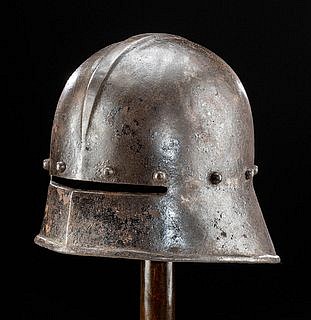9th C. Urartian Bronze Dagger w/ Incised Decorations
Lot 53
About Seller
Artemis Fine Arts
686 S Taylor Ave, Ste 106
Louisville, CO 80027
United States
Selling antiquities, ancient and ethnographic art online since 1993, Artemis Gallery specializes in Classical Antiquities (Egyptian, Greek, Roman, Near Eastern), Asian, Pre-Columbian, African / Tribal / Oceanographic art. Our extensive inventory includes pottery, stone, metal, wood, glass and textil...Read more
Categories
Estimate:
$1,200 - $1,800
Absentee vs Live bid
Two ways to bid:
- Leave a max absentee bid and the platform will bid on your behalf up to your maximum bid during the live auction.
- Bid live during the auction and your bids will be submitted real-time to the auctioneer.
Bid Increments
| Price | Bid Increment |
|---|---|
| $0 | $25 |
| $300 | $50 |
| $1,000 | $100 |
| $2,000 | $250 |
| $5,000 | $500 |
| $10,000 | $1,000 |
| $20,000 | $2,500 |
| $50,000 | $5,000 |
| $100,000 | $10,000 |
| $200,000 | $20,000 |
About Auction
By Artemis Fine Arts
Sep 24, 2020
Set Reminder
2020-09-24 12:00:00
2020-09-24 12:00:00
America/New_York
Bidsquare
Bidsquare : Arms & Armor | Ancient - 20th Century
https://www.bidsquare.com/auctions/artemis-gallery/arms-armor-ancient---20th-century-5672
Specialty auction featuring axes, mace heads, swords, spears, various types of armor, and more! Many different cultures of all price ranges. Great for first-time buyers, seasoned collectors, and dealers alike. All legally acquired, legal to sell. Convenient in-house shipping! Artemis Fine Arts info@artemisgallery.com
Specialty auction featuring axes, mace heads, swords, spears, various types of armor, and more! Many different cultures of all price ranges. Great for first-time buyers, seasoned collectors, and dealers alike. All legally acquired, legal to sell. Convenient in-house shipping! Artemis Fine Arts info@artemisgallery.com
- Lot Description
Ancient Near East/Asia Minor, Anatolia, modern day Turkey/Armenia, Caucasus region, Urartu culture, ca. 9th to 7th century BCE. A wonderful cast-bronze sword with a tapered triangular blade that was shortened in antiquity. Incised down the center of both blade faces is a column of inversely corresponding waves with coalescing crests that is enclosed laterally within a thin pair of concentric bars as well as on top with a trio of omega-shaped bulbs. The rounded blade tip widens gradually to create the sharpened edges and protruding shoulders, and the integral, T-shaped guard tapers to form the narrow handle and openwork pommel. The attenuated blade suggests this blade was either created solely as a votive burial offering or was interred with the body of its owner; the rounded tip indicates the blade has been ritualistically blunted so no other warrior could wield it. Size: 10.9" L x 3.125" W (27.7 cm x 7.9 cm); 6.125" H (15.6 cm) on included custom stand.
Provenance: ex-Auctions Imperial, Henderson, Nevada, USA; ex-private New York, USA collection, originally acquired in the 1960s
All items legal to buy/sell under U.S. Statute covering cultural patrimony Code 2600, CHAPTER 14, and are guaranteed to be as described or your money back.
A Certificate of Authenticity will accompany all winning bids.
We ship worldwide and handle all shipping in-house for your convenience.
#157660Blade tip shortened in antiquity. Very slight bending to blade, with pitting and nicks to blade, edges, and handle, and softening to some incised details on blade faces, otherwise intact and very good. Great patina throughout.Condition
- Shipping Info
-
All shipping is handled in-house for your convenience. Your invoice from Artemis Gallery will include shipping calculation instructions. If in doubt, please inquire BEFORE bidding for estimated shipping costs for individual items.
-
- Buyer's Premium



 EUR
EUR CAD
CAD AUD
AUD GBP
GBP MXN
MXN HKD
HKD CNY
CNY MYR
MYR SEK
SEK SGD
SGD CHF
CHF THB
THB
















